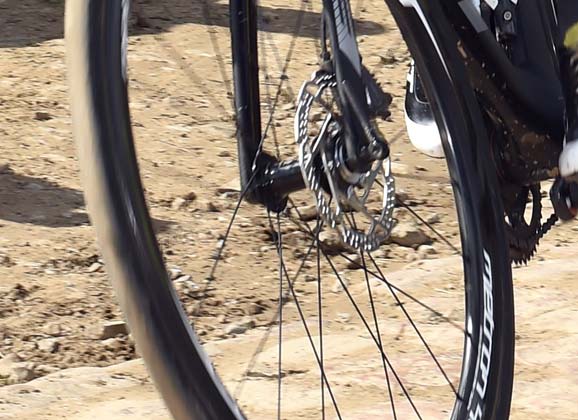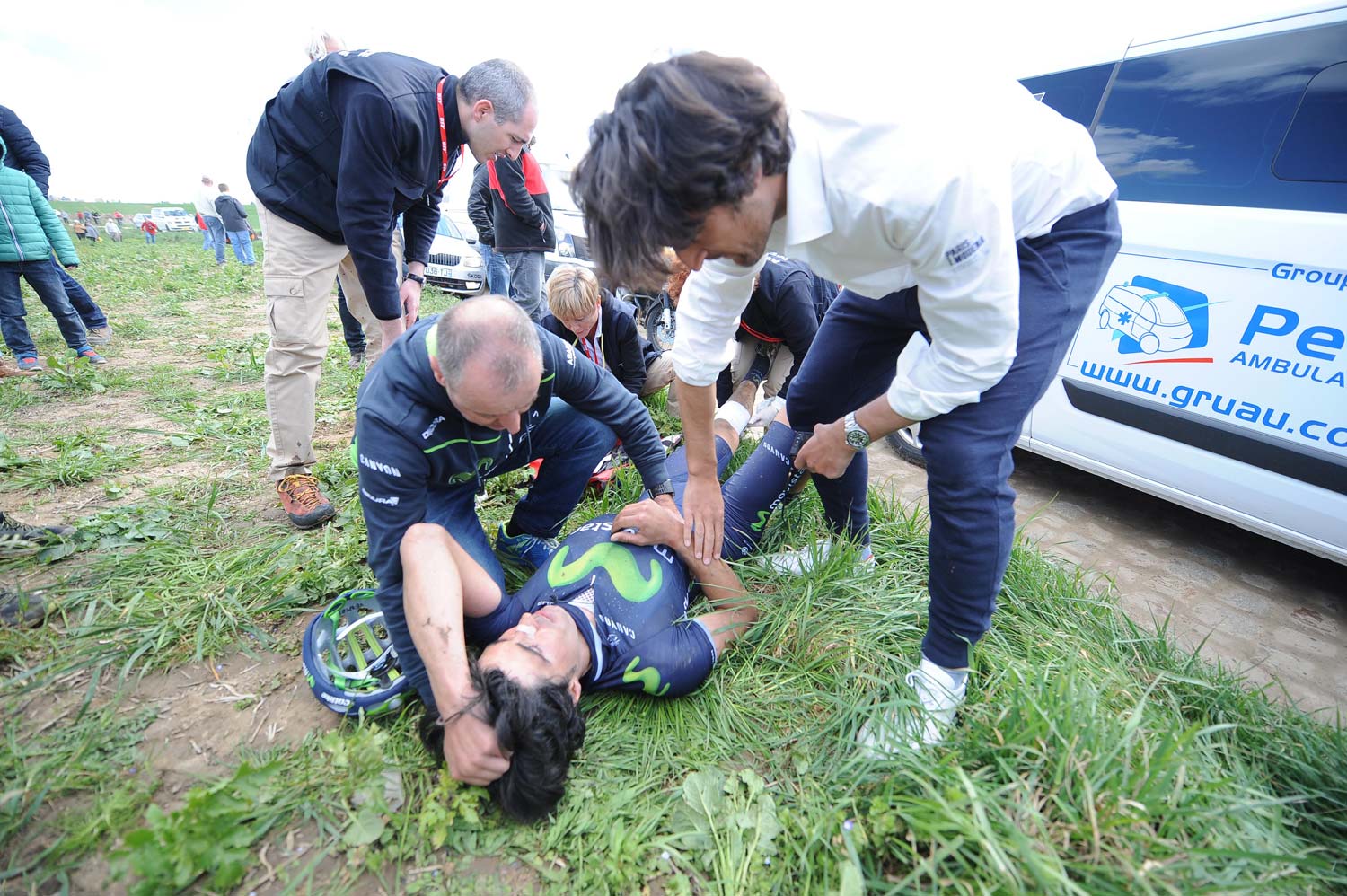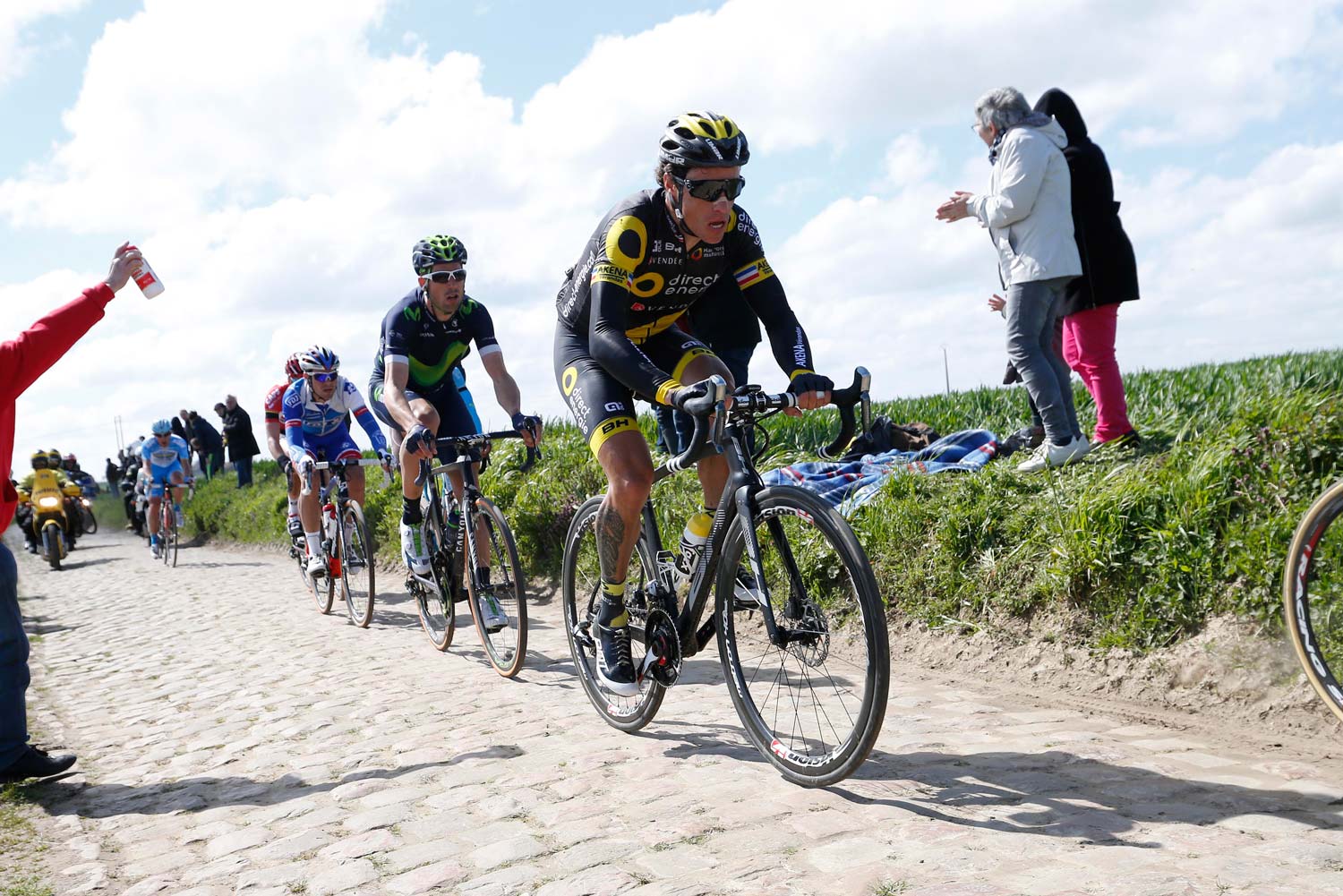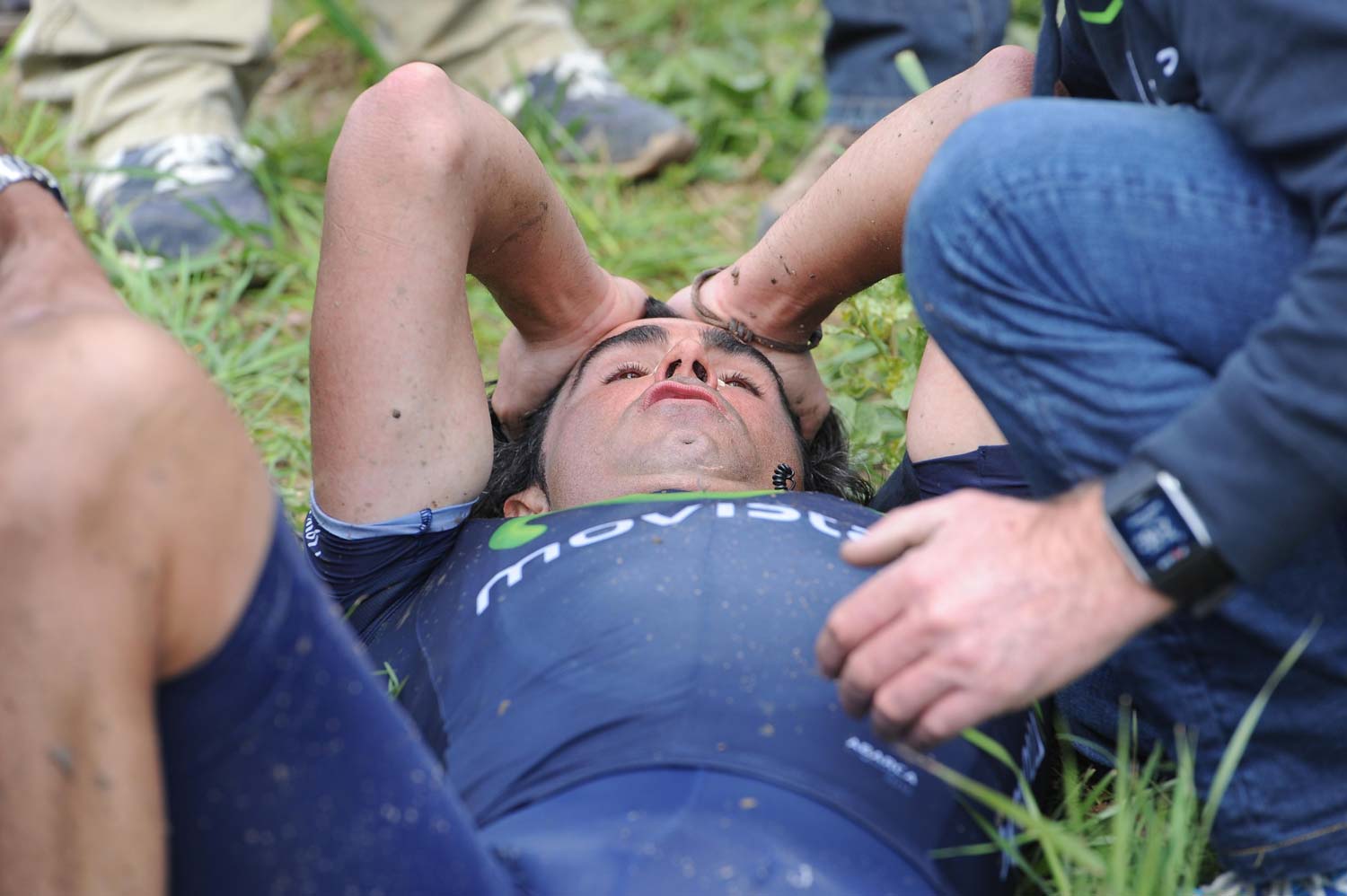It was a trial welcomed by many in the cycling industry but the riders are responding. A couple of cuts sustained during crashes in Paris-Roubaix may see the end of an experiment with disc brakes in the pro peloton. Here’s an overview of the trial that was announced a year ago today but one that appears destined to come to a halt…
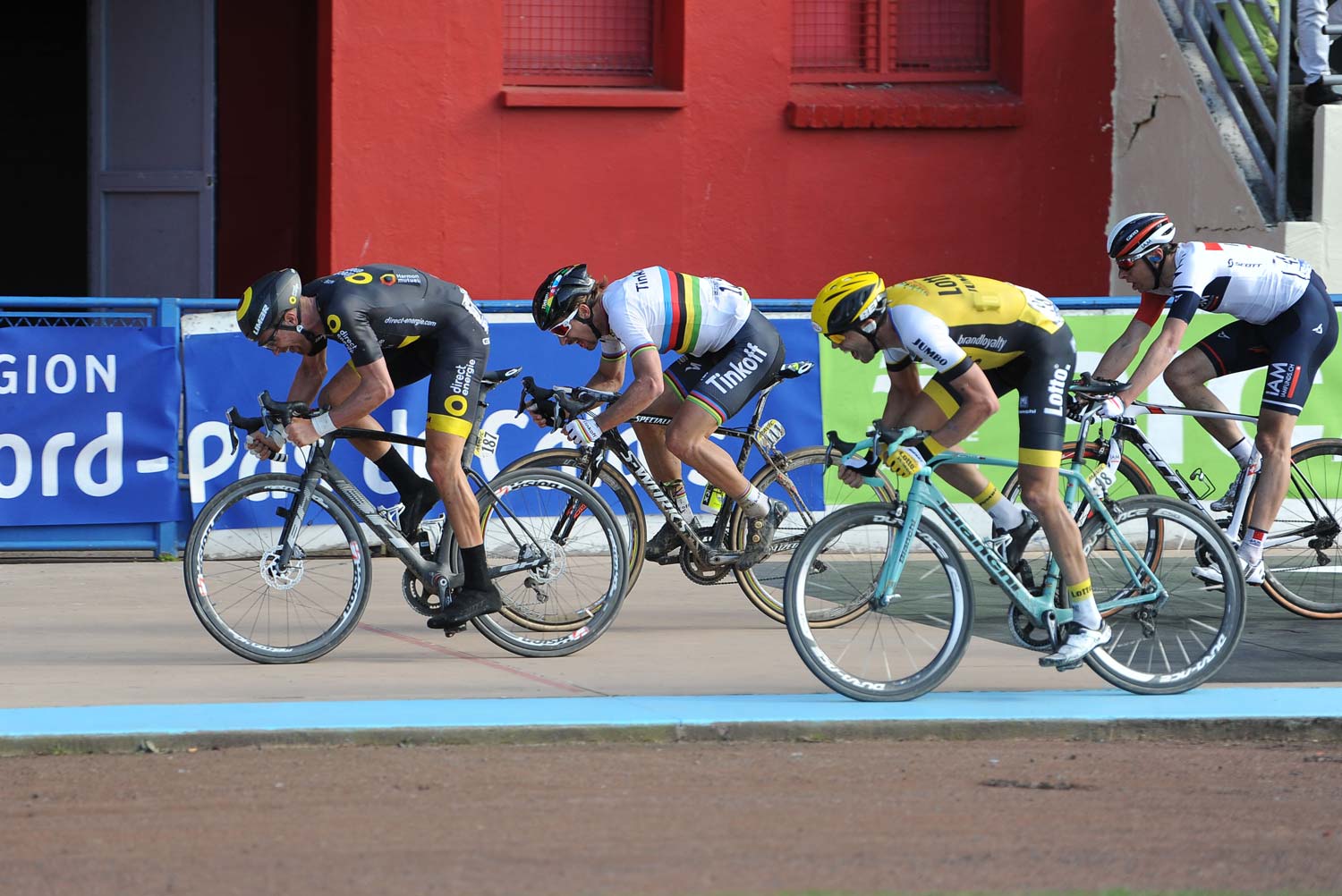
Adrian Petit, from Direct Energie, was the best placed rider to use disc brakes in Paris-Roubaix.
Photo: Yuzuru Sunada
Disc brakes in the WorldTour peloton: 13 August 2015 to 13 April 2016.
Rumours are emerging that the ‘trial’ of using disc brakes in the pro peloton will come to a halt. This comes eight months after a WorldTour team first used disc brakes in competition.
Francisco Ventoso, a rider with the Movistar team had his leg sliced open during an incident in Paris-Roubaix on Sunday 10 April 2016. He laid the blame directly on disc brakes.
“Really, nobody thought they were dangerous?” asks the Spaniard in an open letter posted on the Movistar website.
“Nobody realised they can cut, they can become giant knives?”
His criticism is only explained after he reiterates the benefits of technological improvements for bicycles. He praises many developments in the cycling industry but the tone changes when it comes to the topic of disc brakes.
“Disc brakes should have never arrived into the peloton, not at least as we know them right now,” surmises Ventoso after explaining how he believes his leg was sliced open by a disc during a crash.
He explained the fall and how he quickly remounted his bike before realising the extent of the injuries.
“I have a glance at that leg,” Ventoso explains, “it doesn’t hurt, there’s not a lot of blood covering it, but I can clearly see part of the periosteum, the membrane or surface that covers my tibia. I get off my bike, throw myself against the right-hand side of the road over the grass, cover my face with my hands in shock and disbelief, start to feel sick…”
(See below for the full transcript of Ventoso’s open letter.)
* * * * *
Today, 14 April 2016 – four days after Francisco Ventoso’s injuries were sustained – marks the first anniversary of the UCI’s announcement that disc brakes would be considered.
“Following numerous consultations with different stakeholders,” reads the UCI statement from 14 April 2015, “tests will begin this season with a view to introducing disc brakes to professional road cycling in the future.”
There was considerable pressure from the cycling industry which has been pushing the advantages of disc brakes in recent years. And it seemed like a coup for one UCI sponsor, Shimano, as well as another groupset manufacturer, SRAM.
Both these companies have supplied disc brakes for use in the pro peloton.
The UCI responded by opening the peloton to a ‘trial’ of disc brakes.
“The aim is to eventually introduce disc brakes to all levels of road cycling.”
There was hesitation from some sections of the pro peloton but enthusiasm from others but UCI president Brian Cookson insisted that it would be a consultative process that considered the opinions of all involved.
“Their introduction to road cycling must be carefully studied in collaboration with all those who are directly concerned.”
On 30 November 2015, the UCI had further endorsed the disc brake trial with view to welcoming this technology into road races of all grades.
“The use of disc brakes will be carefully monitored throughout the year with a view to definitively allowing them to be used in professional road cycling from 2017,” stated the UCI late last year.
“Following the decision to further test disc brakes, the UCI has modified articles 1.3.017 and 1.3.020 of its regulations relating to frames and forks. These changes will operate from the 1st of January 2016.
“The UCI has also approved several modifications to its Regulations with regards to saddles and wheel safety characteristics (articles 1.3.014 and 1.3.018). The former will come into force on the 1st December 2015 and the latter on the 1st January 2016.”
* * * * *
At least two teams had used disc brakes in Paris-Roubaix.
Merida, which had hosted a launch of a new disc brake bike in the days leading up to Paris-Roubaix, gave riders from Lampre-Merida the disc brake option.
The Italian team had also used disc brake bikes in the Tour of Flanders, one week earlier. Seven of the eight riders from that team did not finish that race.
Direct Energie was another team that used disc brakes in Paris-Roubaix, with Sylvain Chavanel showing his “giant knives” while in the early breakaway. And Adrian Petit, in 10th place, was the highest place finisher to use disc brakes on Sunday.
There were disc brake wheels on the neutral service cars and organisers had done what they could to cater for this ‘new’ technology.
Ventoso claims he wasn’t alone as a slicing victim.
“Nikolas Maes, a rider from Etixx-Quickstep, comes into the very same ambulance I’m sitting in. There’s a deep wound in his knee, produced by another disc.”
* * * * *
Disc brakes on road bikes has been a hot topic of conversation and one that often polarises opinion. The ‘trial’ had been welcomed by many in the industry but the uptake was scant with riders preferring tried and trusted stopping instead of the new system that, in the event of a mechanical would be slower to service.
The technology is excellent and the consumer – The Everyday Bike Rider – will surely appreciate the benefits of what disc brakes can bring to their bike. But that doesn’t mean it needs to be part of the pro peloton.
We wait for official confirmation from the UCI about the ‘trial’ coming to an end and can be certain that this hot topic is about to warm up even more in the coming days. Stay tuned for more developments.
The debate about the changes to stopping bikes has only just started.
– By Rob Arnold
Related links:
A mechanic’s view of disc brakes in the peloton
Shimano’s WorldTour disc brake debut
Francisco Ventoso’s Open Letter
“I’ve spent 13 years in the pro cycling peloton and another 13 moving up the ladder in youth categories. That makes it 26 years on my bike, training every day, enjoying what I like most, my passion. Since I was six, I’ve enjoyed racing, and I continue to do so. I’m so happy to have turned my vocation into a dream job.
“Just like in any other sport, cycling has evolved in many technical aspects. However, it has not done so in others in a way we’d all have liked.
“Through all these years, I’ve witnessed many improvements on different parts of the bike and cycling apparel. We started off with steel, then aluminium, and later on, carbon. That last one came here to stay, since it was as rigid as we needed while also offering lightness. We’ve also stopped using toe-clips for clipless pedals, much more comfortable, effective and secure. Days are long gone when we used hairnet helmets: modern ones are now lighter, beautiful to the eye and offer absolute security guarantees when you use them.
“I’ve also seen very important improvements on gearing. My first bike had one chainring and three sprockets; nowadays, we use two chainrings, even three, and 11 sprockets… and I’m certain it won’t end there. Technology evolution has been a sort of trial and error: getting to this point hasn’t been easy. I remember how easily chains were broken when we first used ten sprockets: links that broke, because of materials still not as resistant as it was required… it still happens today. We could also talk about the revolution that has brought the electronic shifting. When it was first shown and used, we all were surprised and made early judgments: it’s not necessary, it might not work well, carrying batteries seems wrong, having to connect your bike to AC is bonkers… And now, we can’t imagine our bikes without it.
“My point is: two years ago, we started seeing disc brakes put on cyclocross bikes, and the rumour was that there could be a chance that they be tested in road cycling events.
“Beforehand, I want to make this clear: I’m so in favor as anyone else that cyclocross professionals or participants in sportives enjoy the advantages of disc brakes during their rides.
“But then, there’s pro road cycling events. Was there really anyone who thought things like Sunday’s wouldn’t happen? Really nobody thought they were dangerous? Nobody realised they can cut, they can become giant knives?
“At Paris-Roubaix, only two teams used them. With eight riders each, that makes it 16, carrying a total 32 disc brakes into the peloton. Let me take you to 130km into the race: into a cobbled section, a pile-up splits the field, with riders falling everywhere. I’ve got to break but I can’t avoid crashing against the rider in front of me, who was also trying not to hit the ones ahead. I didn’t actually fall down: it was only my leg touching the back of his bike. I keep riding. But shortly afterwards, I have a glance at that leg: it doesn’t hurt, there’s not a lot of blood covering it, but I can clearly see part of the periosteum, the membrane or surface that covers my tibia. I get off my bike, throw myself against the right-hand side of the road over the grass, cover my face with my hands in shock and disbelief, start to feel sick… I could only wait for my team car and the ambulance, while a lot of things come through my mind.
“Just a stroke of bad luck? I don’t thing so: few kilometres later, one of the thoughts I had sitting in the gutter becomes real.
“15km after my incident, Nikolas Maes, a rider from Etixx-Quick Step, comes into the very same ambulance I’m sitting in. There’s a deep wound in his knee, produced by another disc, one of those 32. One question comes inevitably and immediately to one’s mind: what will happen when 396 discs get into a race where 198 riders ferociously battle for position?
“Disc brakes should have NEVER arrived into the peloton, not at least as we know them right now. I haven’t met any rider who has run out of braking power with traditional brakes; I haven’t known anyone who didn’t see his wheels skidding when you brake with all power you’ve got, no matter traditional or disc brakes. Then: why using them?
“Conversely, there are lots of problems to change wheels after a puncture; added trouble for neutral service, which has to carry three or four different sets of wheels to help you out in case your team car is not around… and the most worrying thing, as I stated before, is that disc brakes in its actual concept are giant knives, ‘machetes’ when crashing against or crashed by them at a certain speed. And in some points, we reach 80, 90, 100 kilometres per hour.
“I’ve been lucky: I didn’t get my leg chopped off, it’s just some muscle and skin. But can you imagine that disk cutting a jugular or a femoral vein? I would prefer not to.
“All of this happens because the international riders’ association – the CPA –, national riders’ associations, international and national feds, teams and, above all of them, OURSELVES, PROFESSIONAL RIDERS, are not doing anything. We always think that it’s not a problem if it doesn’t happen to ourselves. We always wait for horrible things to happen in order to take measures. Sooner or later, it could happen to anybody: it’s a matter of probability, we’ve all got the same. Pro riders should take a look beyond our own belly. Others tell us what we should do, but we just can’t forget WE’VE GOT THE POWER TO CHOOSE, AND WE SHOULD MAKE A CHOICE.
“Disks produce cuts. This time it was me; tomorrow, it can be more serious and happen to others.”


